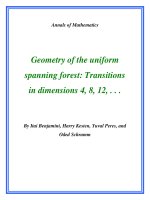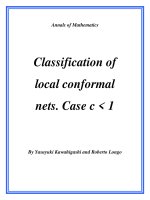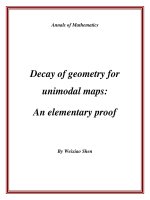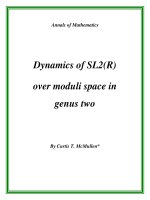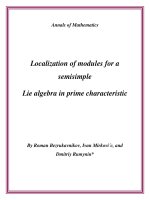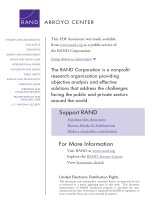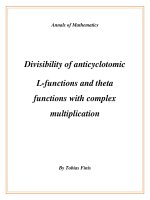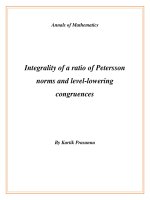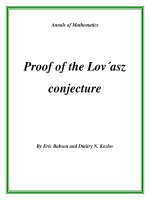Đề tài " Growth of the number of simple closed geodesics on hyperbolic surfaces " docx
Bạn đang xem bản rút gọn của tài liệu. Xem và tải ngay bản đầy đủ của tài liệu tại đây (268.54 KB, 30 trang )
Annals of Mathematics
Growth of the number of
simple closed geodesics on
hyperbolic surfaces
By Maryam Mirzakhani
Annals of Mathematics, 168 (2008), 97–125
Growth of the number of simple
closed geodesics on hyperbolic surfaces
By Maryam Mirzakhani
Contents
1. Introduction
2. Background material
3. Counting integral multi-curves
4. Integration over the moduli space of hyperbolic surfaces
5. Counting curves and Weil-Petersson volumes
6. Counting different types of simple closed curves
1. Introduction
In this paper, we study the growth of s
X
(L), the number of simple closed
geodesics of length ≤ L on a complete hyperbolic surface X of finite area.
We also study the frequencies of different types of simple closed geodesics on
X and their relationship with the Weil-Petersson volumes of moduli spaces of
bordered Riemann surfaces.
Simple closed geodesics. Let c
X
(L) be the number of primitive closed
geodesics of length ≤ L on X. The problem of understanding the asymptotics
of c
X
(L) has been investigated intensively. Due to work of Delsarte, Huber
and Selberg, it is known that
c
X
(L) ∼ e
L
/L
as L →∞. By this result the asymptotic growth of c
X
(L) is independent
of the genus of X. See [Bus] and the references within for more details and
related results. Similar statements hold for the growth of the number of closed
geodesics on negatively curved compact manifolds [Ma].
However, very few closed geodesics are simple [BS2] and it is hard to
discern them in π
1
(X) [BS1].
Counting problems. Let M
g,n
be the moduli space of complete hyperbolic
Riemann surfaces of genus g with n cusps. Fix X ∈M
g,n
. To understand the
98 MARYAM MIRZAKHANI
growth of s
X
(L), it proves fruitful to study different types of simple closed
geodesics on X separately. Let S
g,n
be a closed surface of genus g with n
boundary components. The mapping class group Mod
g,n
acts naturally on the
set of isotopy classes of simple closed curves on S
g,n
. Every isotopy class of a
simple closed curve contains a unique simple closed geodesic on X. Two simple
closed geodesics γ
1
and γ
2
are of the same type if and only if there exists
g ∈ Mod
g,n
such that g · γ
1
= γ
2
. The type of a simple closed geodesic γ is
determined by the topology of S
g,n
(γ), the surface that we get by cutting S
g,n
along γ. We fix a simple closed geodesic γ on X and consider more generally
the counting function
s
X
(L, γ)=#{α ∈ Mod
g,n
·γ |
α
(X) ≤ L}.
Note that there are only finitely many simple closed geodesics on X up to the
action of the mapping class group. Therefore,
s
X
(L)=
γ
s
X
(L, γ),
where the sum is over all types of simple closed geodesics.
We say that γ =
k
i=1
a
i
γ
i
is a multi-curve on S
g,n
if γ
i
’s are disjoint,
essential, nonperipheral simple closed curves, no two of which are in the same
homotopy class, and a
i
> 0 for 1 ≤ i ≤ k. In this case, the length of γ on X is
defined by
γ
(X)=
k
i=1
a
i
γ
i
(X). We call the multi-curve γ integral if a
i
∈ N
for 1 ≤ i ≤ k (or rational if a
i
∈ Q).
In Section 6 we establish the following result:
Theorem 1.1. For any rational multi-curve γ,
lim
L→∞
s
X
(L, γ)
L
6g−6+2n
= n
γ
(X),(1.1)
where n
γ
: M
g,n
→ R
+
is a continuous proper function.
Measured laminations. A key role in our approach is played by the space
ML
g,n
of compactly supported measured laminations on S
g,n
: a piecewise
linear space of dimension 6g−6+2n, whose quotient by the scalars P ML(S
g,n
)
can be viewed as a boundary of the Teichm¨uller space T
g,n
. The space ML
g,n
has a piecewise linear integral structure; the integral points in ML
g,n
are in a
one-to-one correspondence with integral multi-curves on S
g,n
. In fact, ML
g,n
is the completion of the set of rational multi-curves on S
g,n
.
The mapping class group Mod
g,n
of S
g,n
acts naturally on ML
g,n
. More-
over, there is a natural Mod
g,n
-invariant locally finite measure on ML
g,n
, the
Thurston measure μ
Th
, given by this piecewise linear integral structure [Th].
SIMPLE CLOSED GEODESICS ON HYPERBOLIC SURFACES
99
For any open subset U ⊂ML
g,n
,wehave
μ
Th
(t · U)=t
6g−6+2n
μ
Th
(U).
On the other hand, any complete hyperbolic metric X on S
g,n
induces the
length function
ML
g,n
→ R
+
,
λ →
λ
(X),
satisfying
t·λ
(X)=t
λ
(X).
Let B
X
⊂ML
g,n
be the unit ball in the space of measured geodesic lam-
inations with respect to the length function at X (see equation (3.1)), and
B(X)=μ
Th
(B
X
). In Theorem 3.3, we show that the function B : M
g,n
→ R
+
is integrable with respect to the Weil-Petersson volume form. The contribu-
tions of X and γ to n
γ
(X) (defined by equation (1.1)) separate as follows:
Theorem 1.2. For any rational multi-curve γ, there exists a number
c(γ) ∈ Q
>0
such that
n
γ
(X)=
c(γ) · B(X)
b
g,n
,
where b
g,n
=
M
g,n
B(X) · dX < ∞.
Note that c(γ)=c(δ) for all δ ∈ Mod
g,n
·γ.
Notes and references. In the case of g = n = 1, this result was previously
obtained by G. McShane and I. Rivin [MR]. The proof in [MR] relies on
counting the integral points in homology of punctured tori with respect to a
natural norm. See also [Z] for a different treatment of a related problem.
Polynomial lower and upper bounds for s
X
(L) were found by I. Rivin.
More precisely, in [Ri] it is proved that for any X ∈T
g,n
, there exists c
X
> 0
such that
1
c
X
L
6g−6+n
≤ s
X
(L) ≤ c
X
· L
6g−6+2n
.
Similar upper and lower bounds for the number of pants decompositions of
length ≤ L on a hyperbolic surface X were obtained by M. Rees in [Rs].
Idea of the proof of Theorem 1.2. The crux of the matter is to understand
the density of Mod
g,n
·γ in ML
g,n
. This is similar to the problem of the density
of relatively prime pairs (p, q)inZ
2
. Our approach is to use the moduli space
M
g,n
to understand the average of these densities. To prove Theorem 1.2, we:
(I): Apply the results of [Mirz2] to show that the integral of s
X
(L, γ) over
the moduli space M
g,n
P (L, γ)=
M
g,n
s
X
(L, γ) dX
100 MARYAM MIRZAKHANI
is well-behaved. Here the integral on M
g,n
is taken with respect to the Weil-
Petersson volume form. In fact P (L, γ) is a polynomial in L of degree 6g−6+2n
(§5). Let c(γ) be the leading coefficient of P (L, γ). So
c(γ) = lim
L→∞
P (L, γ)
L
6g−6+2n
.(1.2)
(II): Use the ergodicity of the action of the mapping class group on the
space ML
g,n
of measured geodesic laminations on S
g,n
[Mas2] to prove that
these densities exist (§6).
Let μ
γ
denote the discrete measure on ML
g,n
supported on the orbit γ;
that is,
μ
γ
=
g∈Mod
g,n
δ
g·γ
.
The space ML
g,n
has a natural action of R
+
by dilation. For T ∈ R
+
, let
T
∗
(μ
γ
) denote the rescaling of μ
γ
by factor T. Although the action of Mod
g,n
on ML
g,n
is not linear, it is homogeneous. We define the measure μ
T,γ
by
μ
T,γ
=
T
∗
(μ
γ
)
T
6g−6+2n
.
So given U ⊂ML
g,n
,wehaveμ
T,γ
(U)=μ
γ
(T · U)/T
6g−6+2n
.
Then, for any T>0:
• the measure μ
T,γ
is also invariant under the action of Mod
g,n
on ML
g,n
,
and
• it satisfies
μ
T,γ
(B
X
)=
s
X
(T,γ)
T
6g−6+2n
.(1.3)
Therefore, the asymptotic behavior of s
X
(T,γ) is closely related to the asymp-
totic behavior of the sequence {μ
T,γ
}
T
.
In Section 6, we prove the following result:
Theorem 1.3. As T →∞,
μ
T,γ
→
c(γ)
b
g,n
· μ
Th
,(1.4)
where c(γ) is as defined by (1.2)
Note that (1.4) is a statement about the asymptotic behavior of discrete
measures on ML
g,n
, and in some sense it is independent of the geometry of
hyperbolic surfaces.
Frequencies of different types of simple closed curves. From Theorem
1.2, it follows that the relative frequencies of different types of simple closed
curves on X are universal rational numbers.
SIMPLE CLOSED GEODESICS ON HYPERBOLIC SURFACES
101
Corollary 1.4. Given X ∈M
g,n
and rational multi-curves γ
1
and γ
2
on S
g,n
, we have
lim
L→∞
s
X
(L, γ
1
)
s
X
(L, γ
2
)
=
c(γ
1
)
c(γ
2
)
∈ Q
>0
.
Remark. The same result holds for any compact surface X of variable
negative curvature; given a rational multi-curve γ, the rational number c(γ)is
independent of the metric (§6).
The frequency c(γ) ∈ Q of a given simple closed curve can be described in
a purely topological way as follows ([Mirz1]). For any connected simple closed
curve γ,wehave
#({λ an integral multi-curve | i(λ, γ) ≤ k}/ Stab(γ))
k
6g−6+2n
→ c(γ)
as k →∞.
Example.Fori =1, 2, Let α
i
be a curve on S
2
that cuts the surface into
i connected components. Then as L →∞
s
X
(L, α
1
)
s
X
(L, α
2
)
→ 6.
In other words, a very long simple closed geodesic on a surface of genus 2 is
six times more likely to be nonseparating. For more examples see Section 6.
Connection with intersection numbers of tautological line bundles.In
Section 5, we calculate c(γ) in terms of the Weil-Petersson volumes of moduli
space of bordered hyperbolic surfaces. Hence, c(γ) is given in terms of the
intersection numbers of tautological line bundles over the moduli space of Rie-
mann surfaces of type S
g,n
(γ), the surface that we get by cutting S
g,n
along γ
[Mirz3]. See equation (5.5).
An alternative proof. In a sequel, we give a different proof of the growth
of the number of simple closed geodesics by using the ergodic properties of the
earthquake flow on PM
g,n
, the bundle of measured geodesic laminations of
unit length over moduli space.
Acknowledgments. I would like to thank Curt McMullen for his invaluable
help and many insightful discussions related to this work. I am also grateful
to Igor Rivin, Howard Masur, and Scott Wolpert for helpful comments. The
author is supported by a Clay fellowship.
102 MARYAM MIRZAKHANI
2. Background material
In this section, we present some familiar concepts concerning the moduli
space of bordered Riemann surfaces with geodesic boundary components, and
the space of measured geodesic laminations.
Teichm ¨uller space. A point in the Teichm ¨uller space T (S) is a complete
hyperbolic surface X equipped with a diffeomorphism f : S → X. The map f
provides a marking on X by S. Two marked surfaces f : S → X and g : S → Y
define the same point in T (S) if and only if f ◦ g
−1
: Y → X is isotopic to a
conformal map. When ∂S is nonempty, consider hyperbolic Riemann surfaces
homeomorphic to S with geodesic boundary components of fixed length. Let
A = ∂S and L =(L
α
)
α∈A
∈ R
|A|
+
. A point X ∈T(S, L) is a marked hyper-
bolic surface with geodesic boundary components such that for each boundary
component β ∈ ∂S,wehave
β
(X)=L
β
.
Let Mod(S) denote the mapping class group of S, or in other words the group
of isotopy classes of orientation-preserving, self-homeomorphisms of S leaving
each boundary component set-wise fixed.
Let
T
g,n
(L
1
, ,L
n
)=T (S
g,n
,L
1
, ,L
n
)
denote the Teichm¨uller space of hyperbolic structures on S
g,n
, an oriented
connected surface of genus g with n boundary components (β
1
, ,β
n
), with
geodesic boundary components of length L
1
, ,L
n
. The mapping class group
Mod
g,n
=Mod(S
g,n
) acts on T
g,n
(L) by changing the marking. The quotient
space
M
g,n
(L)=M(S
g,n
,
β
i
= L
i
)=T
g,n
(L
1
, ,L
n
)/ Mod
g,n
is the moduli space of Riemann surfaces homeomorphic to S
g,n
with n boundary
components of length
β
i
= L
i
.
By convention, a geodesic of length zero is a cusp and we have
T
g,n
= T
g,n
(0, ,0),
and
M
g,n
= M
g,n
(0, ,0).
For a disconnected surface S =
k
i=1
S
i
such that A
i
= ∂S
i
⊂ ∂S,wehave
M(S, L)=
k
i=1
M(S
i
,L
A
i
),
where L
A
i
=(L
s
)
s∈A
i
.
SIMPLE CLOSED GEODESICS ON HYPERBOLIC SURFACES
103
The Weil-Petersson symplectic form. Recall that a symplectic structure
on a manifold M is a nondegenerate, closed 2-form ω ∈ Ω
2
(M). The n-fold
wedge product
1
n!
ω ∧···∧ω
never vanishes and defines a volume form on M. By work of Goldman [Gol],
the space T
g,n
(L
1
, ,L
n
) carries a natural symplectic form invariant under
the action of the mapping class group. This symplectic form is called the Weil-
Petersson symplectic form, and denoted by ω or ω
wp
. In this paper, we consider
the volume of the moduli space with respect to the volume form induced by
the Weil-Petersson symplectic form. Note that when S is disconnected, we
have
Vol(M(S, L)) =
k
i=1
Vol(M(S
i
,L
A
i
)).
The Fenchel-Nielsen coordinates.Apants decomposition of S is a set of
disjoint simple closed curves which decompose the surface into pairs of pants.
Fix a pants decomposition of S
g,n
, P = {α
i
}
k
i=1
, where k =3g − 3+n.For
a marked hyperbolic surface X ∈T
g,n
(L), the Fenchel-Nielsen coordinates
associated with P, {
α
1
(X), ,
α
k
(X),τ
α
1
(X), ,τ
α
k
(X)}, consist of the
set of lengths of all geodesics used in the decomposition and the set of the
twisting parameters used to glue the pieces. We have an isomorphism [Bus]
T
g,n
(L
1
, ··· ,L
n
)
∼
=
R
P
+
× R
P
by the map
X → (
α
i
(X),τ
α
i
(X)).
By work of Wolpert, the Weil-Petersson symplectic structure has a simple form
in the Fenchel-Nielsen coordinates [Wol].
Theorem 2.1 (Wolpert). The Weil-Petersson symplectic form is given
by
ω
wp
=
k
i=1
d
α
i
∧ dτ
α
i
.
Measured geodesic laminations. Here we briefly sketch some basic proper-
ties of the space of measured geodesic laminations. For more details see [FLP],
[Th] and [HP].
A geodesic lamination on a hyperbolic surface X is a closed subset of X
which is a disjoint union of simple geodesics. A measured geodesic lamination
is a geodesic lamination that carries a transverse invariant measure. Namely,
a compactly supported measured geodesic lamination λ ∈ML
g,n
consists of a
104 MARYAM MIRZAKHANI
compact subset of X foliated by complete simple geodesics and a measure on
every arc k transverse to λ; this measure is invariant under homotopy of arcs
transverse to λ. To understand measured geodesic laminations, it is helpful to
lift them to the universal cover of X. A directed geodesic is determined by a
pair of points (x
1
,x
2
) ∈ (S
∞
× S
∞
) \ Δ, where Δ is the diagonal {(x, x)}.A
geodesic without direction is a point on J =((S
∞
×S
∞
)\Δ)/Z
2
, where Z
2
acts
by interchanging coordinates. Then geodesic laminations on two homeomor-
phic hyperbolic surfaces may be compared by passing to the circle at ∞.As
a result, the spaces of measured geodesic laminations on X, Y ∈T
g,n
are nat-
urally identified via the circle at infinity in their universal covers. The space
ML
g,n
of compactly supported measured geodesic laminations on X ∈T
g,n
only depends on the topology of S
g,n
. Moreover, there is a natural topology
on ML
g,n
, which is induced by the weak topology on the set of all π
1
(S
g,n
)-
invariant measures supported on J.
Train tracks.Atrain track on S = S
g,n
is an embedded 1-complex τ such
that:
• Each edge (branch) of τ is a smooth path with well-defined tangent
vectors at the end points. That is, all edges at a given vertex (switch)
are tangent.
• For each component R of S \ τ, the double of R along the interior of
edges of ∂R has negative Euler characteristic.
The vertices (or switches) of a train track are the points where three or more
smooth arcs come together. The inward pointing tangent of an edge divides the
branches that are incident to a vertex into incoming and outgoing branches.
A lamination γ on S is carried by τ if there is a differentiable map f: S →S
homotopic to the identity taking γ to τ such that the restriction of df to a
tangent line of γ is nonsingular. Every geodesic lamination λ is carried by
some train track τ. When λ has an invariant measure μ, the carrying map
defines a counting measure μ(b) for each edge b of τ. At a switch, the sum of
the entering numbers equals the sum of the exiting numbers.
Let E(τ) be the set of measures on train track τ; more precisely, u ∈
E(τ) is an assignment of positive real numbers on the edges of the train track
satisfying the switch conditions,
incoming
e
i
u(e
i
)=
outgoing
e
j
u(e
j
).
By work of Thurston, we have:
• If τ is a birecurrent train track (see [HP, §1.7]), then E(τ ) gives rise to
an open set U(τ) ⊂ML
g,n
.
SIMPLE CLOSED GEODESICS ON HYPERBOLIC SURFACES
105
• The integral points in E(τ ) are in a one-to-one correspondence with the
set of integral multi-curves in U(τ ) ⊂ML
g,n
.
• The natural volume form on E(τ ) defines a mapping class group invariant
volume form μ
Th
in the Lebesgue measure class on ML
g,n
.
Moreover, up to scale, μ
Th
is the unique mapping class group invariant measure
in the Lebesgue measure class [Mas2]:
Theorem 2.2 (Masur). The action of Mod
g,n
on ML
g,n
is ergodic with
respect to the Lebesgue measure class.
We remark that the space of measured laminations ML
g,n
does not have
a natural differentiable structure [Th].
Length functions. The hyperbolic length
γ
(X) of a simple closed geodesic
γ on a hyperbolic surface X ∈T
g,n
determines a real analytic function on the
Teichm¨uller space. The length function can be extended by homogeneity and
continuity on ML
g,n
[Ker]. More precisely, there is a unique continuous map
L: ML
g,n
×T
g,n
→ R
+
,(2.1)
such that
• for any simple closed curve α, L(α, X)=
α
(X),
• for t ∈ R
+
, L(t · λ, X)=t · L(λ, X), and
• for any h ∈ Mod
g,n
, L(h · λ, h · X)=L(λ, X).
For λ ∈ML
g,n
,
λ
(X)=L(λ, X) is the geodesic length of the measured
lamination λ on X. For more details see [Th].
3. Counting integral multi-curves
In this section, we study the growth of the number of integral multi-curves
of length ≤ L on a hyperbolic Riemann surface X. To simplify notation, let
ML
g,n
(Z) denote the set of integral multi-curves on S
g,n
.
Counting integral multi-curves. Define b
X
(L)by
b
X
(L)=#{γ ∈ML
g,n
(Z) |
γ
(X) ≤ L}.
In other words, b
X
(L) is the number of integral points in L · B
X
⊂ML
g,n
,
where
B
X
= {λ ∈ML
g,n
|
λ
(X) ≤ 1 }.(3.1)
In fact the subset B
X
⊂ML
g,n
is locally convex [Mirz1].
106 MARYAM MIRZAKHANI
The function B : T
g,n
→ R
+
defined by
B(X)=μ
Th
(B
X
)(3.2)
plays an important role in this section.
Proposition 3.1. For any X ∈T
g,n
,
b
X
(L)
L
6g−6+2n
→ B(X)
as L →∞.
Proof of Proposition 3.1. For any train track τ on S
g,n
, define
b
τ
(U, L)=#(ML
g,n
(Z) ∩ (L · U) ∩ U
τ
).
Recall that U
τ
has a linear integral structure (§2), and the points in U
τ
∩
ML
g,n
(Z) are in a one-to-one correspondence with the integral points in this
chart. Therefore by basic lattice counting estimates, we get
b
τ
(U, L)
L
6g−6+2n
→ μ
Th
(U ∩ U
τ
)(3.3)
as L →∞. Cover ML
g,n
by finitely many train-track charts U
τ
1
, ,U
τ
k
.
Since the transition functions are volume-preserving, the result follows from
equation (3.3) applied to each chart U
τ
i
.
Note that the function B descends to a function over M
g,n
. On the other
hand, given λ ∈ML
g,n
, the length function
λ
: T
g,n
→ R
+
is smooth [Ker]. Hence we have:
Proposition 3.2. The function B : M
g,n
→ R
+
, defined by equation
(3.2), is continuous.
In this section, we show that
b
g,n
=
M
g,n
B(X) · dX < ∞,(3.4)
where the integral is with respect to the Weil-Petesson volume form.
Theorem 3.3. The function B is proper and integrable over M
g,n
.
The proof relies on explicit upper and lower bounds for B(X) obtained in
Proposition 3.6. For an explicit calculation of b
g,n
, see Theorem 5.3.
Dehn’s coordinates for multi-curves. Let
P = {α
1
, ,α
3g−3+n
}
SIMPLE CLOSED GEODESICS ON HYPERBOLIC SURFACES
107
be a maximal system of simple closed curves on S
g,n
. In order to prove Theo-
rem 3.3, we estimate the hyperbolic length of a multi-curve on X in terms of
its combinatorial length with respect to a pants decomposition (see eq. (3.6)).
Consider the Dehn-Thurston parametrization [HP] of the set of multi-
curves defined by
DT : ML
g,n
(Z) → (Z
+
× Z)
3g−3+n
(3.5)
γ → (m
i
,t
i
)
3g−3+n
i=1
,
where m
j
= i(γ,α
j
) ∈ Z
+
is the intersection number of γ and α
j
, and t
j
=
tw(γ, α
j
) ∈ Z is the twisting number of γ around α
j
. Dehn’s theorem asserts
that these parameters uniquely determine a multi-curve.
Let Z(P) be the set of (m
i
,t
i
)
3g−3+n
i=1
∈ (Z
+
× Z)
3g−3+n
such that the
following conditions are satisfied:
Z-1. If m
i
= 0, then t
i
≥ 0.
Z-2. If α
i
1
, α
i
2
, α
i
3
bound an embedded pair of pants in S
g,n
, then m
i
1
+m
i
2
+
m
i
3
is even.
Then we have:
Theorem 3.4 (Dehn). For any pants decomposition P of S
g,n
, the map
DT : ML
g,n
(Z) → Z(P)
is a bijection.
See [HP] for more details.
Combinatorial lengths of multi-curves. Let γ be a multi-curve on X ∈
T
g,n
. Define the combinatorial length of γ with respect to a pants decomposi-
tion P = {α
1
, ,α
3g−3+n
} by
L
P
(X, γ)=
3g−3+n
i=1
(m
i
· S(
α
i
(X)) + |t
i
|·
α
i
(X)) ,(3.6)
where S(x) = arcsinh
1
sinh(x/2)
. Note that S(x) is equal to the width of the
collar neighborhood around a simple closed geodesic of length x on a hyperbolic
surface [Bus].
We say a pants decomposition P is L−bounded on X ∈T
g,n
if |τ
α
(X)|≤
α
(X) ≤ L for every α ∈P.
Proposition 3.5. Let P be an L−bounded pants decomposition of X ∈
T
g,n
. Then for any multi-curve γ on X,
1
c
L
P
(X, γ) ≤
γ
(X) ≤ cL
P
(X, γ),(3.7)
where the constant c depends only on L, g and n.
108 MARYAM MIRZAKHANI
Proof. First we prove the lower bound on
γ
(X)in(3.7). Our proof is
inspired by some of the ideas used in [DS] (§5.1).
Without loss of generality, we can assume that γ is a connected simple
closed geodesic on X. Fix an orientation on γ. Let p
1
, ···p
r
be the ordered set
of intersection points of γ with P (with respect to the orientation of γ) such
that p
j
∈ α
k
j
. Here 1 ≤ k
j
≤ 3g − 3+n, and
r = i(γ,P)=
3g−3+n
j=1
i(γ,α
j
).
Let γ
j
denote the segment of γ between p
j−1
and p
j+1
, where p
0
= p
r
, and
p
r+1
= p
1
. Define
t
j
to be the twisting number of the arc γ
j
around the curve
α
k
j
. Then one can verify easily that
• 2
γ
(X)=
r
i=1
(γ
j
),
• i(γ,α
i
)=#{j |k
j
= i}, and
•|t
i
| =
{j : k
j
=i}
|
t
j
|.
We show that in terms of the above notation,
(γ
j
) ≥ c
1
(S(
α
k
j
(X)) + |
t
j
|
α
k
j
(X)),(3.8)
where c
1
is a constant which only depends on L.
Let ˜γ be the lift of γ through p
j−1
. Let
C
j−1
,
C
j
and
C
j+1
be the lifts of
α
k
j−1
, α
k
j
and α
k
j+1
which are intersected in order by γ such that
C
j−1
∩ ˜γ =
p
j−1
. Then
C
i
and
C
i+1
project to two boundary components of a pair of pants
in P.
For i = j − 1,j, consider the common perpendicular segment to
C
i
,
C
i+1
,
with end-points denoted by Q
+
i
,Q
−
i+1
. Let s
j
, d
j−1
and d
j
be respectively the
geodesic length of arcs Q
−
j
Q
+
j
,Q
+
j−1
Q
−
j
and Q
+
j
Q
−
j+1
. See Figure 1.
Q
+
j−1
Q
−
j
p
j
p
j+1
p
j−1
Q
+
j
Q
−
j+1
Figure 1
SIMPLE CLOSED GEODESICS ON HYPERBOLIC SURFACES
109
Then we have:
• d
j
≥ S(
α
k
j
), and
• the shift s
j
is given by s
j
= |
t
j
α
k
j
+ τ
α
k
j
+ e
j
|, where |e
j
| <
α
k
j
. Since
|τ
α
k
j
|≤
α
k
j
,wegets
j
≥ (|
t
j
|−2)
α
k
j
.
Here both e
j
and
t
j
are independent of the geometry of X. They only depend
on the topology of γ relative to the pants decomposition P. See §5.1 in [DS]
for more details.
As a result we have
d
j
+ s
j
≥ S(
α
k
j
)+(|
t
j
|−2)
α
k
j
.(3.9)
Since P is L−bounded,
α
i
(X) ≤ L, and there exists a constant D
L
> 0
such that d
j
≥ D
L
. Now equation (3.8) follows from the next two basic obser-
vations:
(1) Let p
1
and p
2
be two points of distance x and z to a geodesic line.
Consider the geodesic quadrangle p
1
q
1
q
2
p
2
such that d(q
1
,q
2
)=y, d(p
1
,q
1
)=x,
and d(q
2
,p
2
)=z.Ify ≥ D(L), then
d = d(p
1
,p
2
) ≥ c(L)(x + y + z),(3.10)
where c(L) is a constant depending only on L. To prove (3.10), note that by
basic hyperbolic trigonometry,
cosh(d) = cosh(x) cosh(z) cosh(y) − sinh(x) sinh(z).
Here x and z are oriented lengths; if p
1
and p
2
lie on opposite sides of q
1
q
2
,
then x and z have opposite signs. See §2.3.2 of [Bus]. This formula implies
that cosh(d) ≥ cosh(x) cosh(z)(cosh(y)−1). Hence there exists K = K(L) > 0
such that
d ≥ x + y + z − K(L);(3.11)
see Lemma 5.1 of [DS]. Since d ≥ D(L), it is easy to see that
d ≥ min{
1
2
,
D(L)
2K(L)
}(x + y + z).
(2) Note that for 0 ≤ x ≤ L, S(x)/x is bounded from below. Hence, by
(3.9) there exists a constant c
2
such that
d
j
+ s
j
≥ c
2
(L)(S(
α
k
j
)+|
t
j
|
α
k
j
).(3.12)
Therefore, by (3.10) for geodesic quadrangles p
j−1
Q
+
j−1
Q
−
j
p
j
and
p
j
Q
+
j
Q
−
j+1
p
j+1
we have
(γ
j
) ≥ c(L)(d
j
+ s
j
).(3.13)
110 MARYAM MIRZAKHANI
Now equation (3.8) follows from (3.12) and (3.13). By adding the inequality
(3.8) for 1 ≤ j ≤ r,weget
γ
(X)=
1
2
r
j=1
(γ
j
) ≥ C(L)L
P
(X, γ).
Let d(α, β) denote the length of the shortest geodesic path joining two bound-
aries α and β of a pair of pants in the pants decomposition P. To obtain the
upper bound on
γ
(X), it is enough to note that d(α, β) ≤ c
3
(S(
α
(X)) +
S(
β
(X))), where the constant c
3
depends only on L.
Upper and lower bounds for B(X). Next, we find upper and lower bounds
for the function B(X) in terms of the lengths of short geodesics on X. Define
R: R
+
→ R
+
by
R(x)=
1
x | log(x)|
.
Proposition 3.6. For any X ∈T
g,n
, sufficiently small ε>0 and 1 ≤ L,
C
1
·
γ :
γ
(X)≤ε
R(
γ
(X)) ≤ B(X),(3.14)
and
b
X
(L)
L
6g−6+2n
≤ C
2
·
γ :
γ
(X)≤ε
1
γ
(X)
,(3.15)
where C
1
,C
2
> 0 are constants depending only on g,n and ε.
Sketch of the proof. Take ε small enough such that no two closed geodesics
of length ≤ ε on a hyperbolic surface meet. For X ∈T
g,n
, let α
1
, ,α
s
be
the set of all simple closed geodesics of length ≤ ε on X and
P
X
= {α
1
, ,α
s
, ,α
k
}
be a maximal set of disjoint simple closed geodesics such that
α
i
(X) ≤ L
g,n
,
where k =3g − 3+n, and L
g,n
is the Bers’ constant for S
g,n
(see [Bus]). We
can assume that P
X
is L
g,n
−bounded on X.
Given x, y, L > 0, consider the set A
x,y
(L) defined by
A
x,y
(L)={(m, n) | mx + ny ≤ L}⊂Z
+
× Z
+
.
Then for L>6 max{x, y}
1
12
L
2
x · y
≤|A
x,y
(L)|.(3.16)
Also, for L>1
|A
x,y
(L)|≤3
L
2
x · y
+
L
min{x, y}
+1
≤ 3L
2
(1 +
1
x · y
+
1
min{x, y}
).(3.17)
SIMPLE CLOSED GEODESICS ON HYPERBOLIC SURFACES
111
Now we can estimate b
X
(L), the number of integral multi-curves of length
≤ L on X, by applying (3.7). We use the combinatorial length of multi-curve
geodesics with respect to the pants decomposition P
X
instead of their geodesic
length on X. By setting x
i
= S(
α
i
(X)), y
i
=
α
i
(X), Theorem 3.4 implies
that
1
c
k
i=1
A
x
i
,y
i
(
L
k
) ≤ b
X
(L) ≤ c
k
i=1
A
x
i
,y
i
(L),(3.18)
where c>0 is a constant independent of X and L. Note that
{(m
i
,t
i
)
3g−3+n
i=1
|∀i 1 ≤ i ≤ 3g − 3+n, t
i
> 0,m
i
∈ 2Z
+
}⊂Z(P).
On the other hand,
S(x)/| log(x)|→1
as x → 0. It is easy to check that:
• 1/c
0
≤ x · S(x) ≤ c
0
, for ε ≤ x ≤ L
g,n
,
• c
1
≤ max{x, S(x)}, and
• min{x, S(x)}≤c
2
.
Here c
0
,c
1
and c
2
are constants which only depend on g, n and ε. Therefore,
(3.14) follows from (3.16) and (3.18). Similarly, (3.15) follows from (3.17) and
(3.18).
Properness and integrability of the function B. In this part we show that
the upper bound in (3.15) is an integrable proper function.
Proof of Theorem 3.3. Note that inf{
γ
}
γ
→ 0asX →∞in M
g,n
. Also,
R(ε) →∞
as ε → 0. So equation (3.14) implies the function B is proper.
Next we prove that the function F : M
g,n
→ R defined by
F (X)=
γ :
γ
(X)≤ε
1
γ
(X)
,(3.19)
is integrable with respect to the Weil-Petersson volume form on M
g,n
. Let
M
k,ε
g,n
⊂M
g,n
be the subset consisting of surfaces with k simple closed geodesics
of length ≤ ε. Note that using the Fenchel-Nielson coordinates, the set M
k,ε
g,n
can be covered by finitely many open sets of the form
π({(x
i
,y
i
)
3g−3+n
1
| 0 ≤ x
1
, x
k
≤ ε, x
i
≤ L
g,n
, 0 ≤ y
i
≤ x
i
}).
See Section 2. By Theorem 2.1, it is enough to note that for
V
ε,k
= {(x
i
,y
i
)
k
1
| 0 ≤ x
1
, x
k
≤ ε, 0 ≤ y
i
≤ x
i
}
112 MARYAM MIRZAKHANI
β
3
β
1
β
2
α
β
4
β
3
α
1
α
2
β
4
β
1
β
2
Figure 2. Cutting a surface along a multi-curve
we have
V
ε,k
1
x
1
···x
k
dx
1
···dx
k
· dy
1
···dy
k
< ∞.
Define f
L
: M
g,n
→ R
+
by
f
L
(X)=
b
X
(L)
L
6g−g+2n
.
By Proposition 3.6, the sequence {f
L
}
L≥1
satisfies the hypothesis of Lebesgue’s
dominated convergence theorem. In fact, for every integral multi-curve γ on
S
g,n
,wehave
s
X
(L, γ)
L
6g−6+2n
≤ f
L
(X) ≤ C
2
· F (X),(3.20)
where the function F , defined by (3.19), is integrable over M
g,n
.
4. Integration over the moduli space of hyperbolic surfaces
In this section, we recall the results obtained in [Mirz2] and [Mirz3] for
integrating certain geometric functions over the moduli space of hyperbolic
surfaces.
Symmetry group of a simple closed curve. For any set A of homotopy
classes of simple closed curves on S
g,n
, define Stab(A)by
Stab(A)={g ∈ Mod
g,n
| g · A = A}⊂Mod
g,n
.
Let γ =
k
i=1
a
i
γ
i
, be a multi-curve on S
g,n
. Define the symmetry group of γ,
Sym(γ), by
Sym(γ) = Stab(γ)/ ∩
k
i=1
Stab(γ
i
).
Note that for any connected simple closed curve α, | Sym(α)| =1.
SIMPLE CLOSED GEODESICS ON HYPERBOLIC SURFACES
113
Splitting along a simple closed curve. Consider the surface S
g,n
\U
γ
, where
U
γ
is an open set homeomorphic to
k
1
((0, 1) × γ
i
). We denote this surface
by S
g,n
(γ), which is a (possibly disconnected) surface with n +2k boundary
components and s = s(γ) connected components. Each connected component
γ
i
of γ, gives rise to two boundary components, γ
1
i
and γ
2
i
on S
g,n
(γ). Namely,
∂(S
g,n
(γ)) = {β
1
, ,β
n
}∪{γ
1
1
,γ
2
1
, ,γ
1
k
,γ
2
k
}.
Now for Γ = (γ
1
, ,γ
k
), and x =(x
1
, ,x
k
) ∈ R
k
+
, let
T (S
g,n
(γ),
Γ
= x)
be the Teichm¨uller space of hyperbolic Riemann surfaces homeomorphic to
S
g,n
(γ) such that
γ
i
= x
i
and
β
i
= 0. The group G(Γ) = ∩
k
i=1
Stab(γ
i
)
naturally acts on T (S
g,n
(γ),
Γ
= x). Now, define
M
g,n
(Γ, x)=T (S
g,n
(γ),
Γ
= x)/G(Γ).
Let Stab
0
(α) ⊂ Stab(α) denote the subgroup consisting of elements which
preserve the orientation of α. Then any g ∈∩
k
i=1
Stab
0
(γ
i
) can be thought of
as an element in Mod(S
g,n
(γ)). Hence for (g, n) =(1, 1), M(S
g,n
(γ),
Γ
= x)
is a finite cover of M
g,n
(Γ, x) of order
N(γ)=
k
i=1
Stab(γ
i
)/
k
i=1
Stab
0
(γ
i
)
.
Therefore,
Vol
wp
(M
g,n
(Γ, x)) =
1
N(γ)
s
i=1
V
g
i
,n
i
(
A
i
),(4.1)
where
S
g,n
(γ)=
s
i=1
S
i
,
S
i
∼
=
S
g
i
,n
i
, and A
i
= ∂S
i
.
There is an exceptional case which arises when g = n = 1. In this
case, every X ∈M
1,1
has a symmetry of order 2, τ ∈ Stab(γ). As a result,
Vol(M
1,1
(Γ,x)) = 1.
Example. Let α be a connected nonseparating simple closed curve α on
S
g,n
. Then there exists an element in Stab(α) which reverses the orientation
of α, and hence N(α)=2.
Simple closed curves on X ∈M
g,n
. Let [γ] denote the homotopy class of
a simple closed curve γ on S
g,n
. Although there is no canonical simple closed
geodesic on X ∈M
g,n
corresponding to [γ], the set
O
γ
= {[α]| α ∈ Mod ·γ},
114 MARYAM MIRZAKHANI
of homotopy classes of simple closed curves in the Mod
g,n
-orbit of γ on X,is
determined by γ. In other words, O
γ
is the set of [φ(γ)] where φ: S
g,n
→ X is
a marking of X.
Integration over the moduli space of hyperbolic surfaces. For a multi-curve
γ =
k
i=1
a
i
γ
i
,wehave
γ
(X)=
k
i=1
a
i
γ
i
(X).
Given a continuous function f : R
+
→ R
+
,
f
γ
(X)=
[α]∈Mod ·[γ]
f(
α
(X)),(4.2)
defines a function f
γ
: M
g,n
→ R
+
. Then we can calculate the integral of f
γ
over M
g,n
using the following result [Mirz2]:
Theorem 4.1. For any multi-curve γ =
k
i=1
a
i
γ
i
, the integral of f
γ
over
M
g,n
with respect to the Weil-Petersson volume form is given by
M
g,n
f
γ
(X) dX =
2
−M(γ)
| Sym(γ)|
x∈
R
k
+
f(|x|) V
g,n
(Γ, x) x · dx,
where Γ=(γ
1
, ,γ
k
), |x| =
k
i=1
a
i
x
i
, x · dx = x
1
···x
k
· dx
1
∧···∧dx
k
,
M(γ)=|{i|γ
i
separates off a one-handle from S
g,n
}|,
and
V
g,n
(Γ, x)=Vol
wp
(M
g,n
(Γ, x)).
By Theorem 4.1, integrating f
γ
, even for a compact Riemann surface,
reduces to the calculation of volumes of moduli spaces of bordered Riemann
surfaces.
Idea of the proof of Theorem 4.1. Here we briefly sketch the main idea of
how to calculate the integral of f
γ
over M
g,n
with respect to the Weil-Petersson
volume form when γ is a connected simple closed curve. See [Mirz2] for more
details.
First, consider the covering space of M
g,n
π
γ
: M
γ
g,n
= {(X, α) | X ∈M
g,n
, and α ∈O
γ
is a geodesic on X }→M
g,n
,
where π
γ
(X, α)=X. The hyperbolic length function descends to the function
: M
γ
g,n
→ R
+
SIMPLE CLOSED GEODESICS ON HYPERBOLIC SURFACES
115
defined by (X, η)=
η
(X). Therefore,
M
g,n
f
γ
(X) dX =
M
γ
g,n
f ◦ (Y ) dY.
On the other hand, the function f is constant on each level set of and we
have
M
γ
g,n
f ◦ (Y ) dY =
∞
0
f(t) Vol(
−1
(t)) dt,
where the volume is taken with respect to the volume form induced on
−1
(t).
The decomposition of the surface along the simple closed curve γ gives rise
to a description of M
γ
g,n
in terms of moduli spaces corresponding to simpler
surfaces. This observation leads to formulas for the integral of f
γ
in terms
of the Weil-Petersson volumes of moduli spaces of bordered Riemann surfaces
and the function f as follows.
As before, let S
g,n
(γ) denote the surface obtained by cutting the surface
S
g,n
along γ. Also, T
g,n
(γ,
γ
= t) denotes the Teichm¨uller space of Riemann
surfaces homeomorphic to S
g,n
(γ) such that the lengths of the two boundary
components corresponding to γ are equal to t. We have a natural circle bundle
−1
(t) ⊂M
γ
g,n
⏐
⏐
M
g,n
(γ,
γ
= t)=T
g,n
(γ,
γ
= t)/ Stab(γ).
We consider the S
1
-action on the level set
−1
(t) ⊂M
γ
g,n
induced by twisting
the surface along γ. The quotient space
−1
(t)/S
1
inherits a symplectic form
from the Weil-Petersson symplectic form. On the other hand, M
g,n
(γ,
γ
= t)
is equipped with the Weil-Petersson symplectic form. Also,
−1
(t)/S
1
∼
=
M
g,n
(γ,
γ
= t)
as symplectic manifolds. So we expect to have
Vol(
−1
(t)) = t Vol(M
g,n
(γ,
γ
= t)).
But the situation is different when γ separates off a one-handle in which case
the length of the fiber of the S
1
-action at a point is in fact t/2 instead of t
[Mirz2]. Hence, for any connected simple closed curve γ on S
g,n
,
M
g,n
f
γ
(X) dX =2
−M(γ)
∞
0
f(t) t Vol(M
g,n
(γ,
γ
= t)) dt,(4.3)
where M(γ)=1ifγ separates off a one-handle, and M(γ) = 0 otherwise.
116 MARYAM MIRZAKHANI
The Weil-Petersson volumes of the moduli spaces of hyperbolic surfaces.
In [Mirz2], by using an identity for the lengths of simple closed geodesics on
hyperbolic surfaces and using Theorem 4.1, we obtain a recursive method for
calculating volume polynomials.
Theorem 4.2. The volume V
g,n
(b
1
, ,b
n
)=Vol
wp
(M
g,n
(b)) is a poly-
nomial in b
2
1
, ,b
2
n
; that is,
V
g,n
(b)=
α
|α|≤3g−3+n
C
α
· b
2α
,
where C
α
> 0 lies in π
6g−6+2n−|2 α|
· Q.
Theorem 4.3. The coefficient C
α
in Theorem 4.2 is given by
C
α
=
1
2
|α|
|α|!(3g − 3+n −|α|)!
M
g,n
ψ
α
1
1
···ψ
α
n
n
· ω
3g−3+n−|α|
,(4.4)
where ψ
i
is the first Chern class of the i
th
tautological line bundle, ω is the
Weil-Petersson symplectic form, α!=
n
i=1
α
i
!, and |α| =
n
i=1
α
i
.
See [Mirz2] and [Mirz3] for more details.
Examples. One can use the recursive formula obtained in [Mirz2], or other
similar recursive formulas to calculate the coefficients of the volume polynomi-
als.
(1) By [Mirz2],
V
1,1
(b)=
1
24
(b
2
+4π
2
) ,(4.5)
V
1,2
(b
1
,b
2
)=
1
192
(4π
2
+ b
2
1
+ b
2
2
)(12π
2
+ b
2
1
+ b
2
2
).(4.6)
(2) In general, for g =0,
M
0,n
ψ
α
1
1
···ψ
α
n
n
=
n − 3
α
1
α
n
.
(3) For n = 1 and g>1, we have [FP], [IZ]:
M
g,1
ψ
6g−4
1
=
1
24
g
g!
.
SIMPLE CLOSED GEODESICS ON HYPERBOLIC SURFACES
117
Therefore, by Theorem 4.3 the leading coefficient of the polynomial
V
g,1
(L) is equal to
L
6g−4
24
g
g!(3g − 2)!2
3g−2
.(4.7)
For more on calculating intersection pairings over
M
g,n
see [ArC].
5. Counting curves and Weil-Petersson volumes
In this section we establish a relationship between s
X
(L, γ) and the
Weil-Petersson volume of moduli spaces of bordered Riemann surfaces. We
use this relationship to calculate b
g,n
in terms of the leading coefficients of
volume polynomials.
Let P (L, γ) be the integral of s
X
(L, γ) over M
g,n
, given by
P (L, γ)=
M
g,n
s
X
(L, γ) dX.
Now by using Theorem 4.1 for f = χ([0,L]), we obtain the following result:
Proposition 5.1. For any multi-curve γ =
k
i=1
a
i
γ
i
, the integral of
s
X
(L, γ) is given by
P (L, γ)=
2
−M(γ)
| Sym(γ)|
L
0
k
i=1
a
i
·x
i
=T
V
g,n
(Γ, x) x dx dT,(5.1)
where x =(x
1
, ,x
k
), and Γ=(γ
1
, ,γ
k
).
Note that even though V
g,n
(Γ, x) depends on the choice of Γ = (γ
1
, ,γ
k
),
the right-hand side of (5.1) only depends on γ. Using Theorem 4.2, we get:
Corollary 5.2. For any multi-curve γ, P (L, γ) is a polynomial of degree
6g−6+2n in L.Ifγ is a rational multi-curve, then c(γ), the leading coefficient
of this polynomial, is a positive rational number.
Notation. Define c(γ)by
c(γ) = lim
L→∞
P (L, γ)
L
6g−6+2n
.(5.2)
By Corollary 5.2, c(γ) is the coefficient of L
6g−6+2n
in P (L, γ). Moreover, if γ
is a rational multi-curve, then by Theorem 4.2, c(γ) ∈ Q
>0
.
118 MARYAM MIRZAKHANI
Let Γ = (γ
1
, ,γ
k
). Recall that by Theorem 4.2,
Vol
wp
(M
g,n
(Γ, x))
is a polynomial of degree 6g − 6+2n −2k in x
1
, x
k
(see equation (4.1)). Let
(2s
1
, 2s
k
)
Γ
∈ Q
>0
denote the coefficient of x
2s
1
1
···x
2s
k
k
in this polynomial,
and
b
Γ
(2s
1
, ,2s
k
)=(2s
1
, 2s
k
)
Γ
k
i=1
(2s
i
+ 1)!
(6g − 6+2n)!
.(5.3)
Also, as before
M(γ)=|{i|γ
i
separates off a one-handle from S
g,n
}|.
Let
S
g,n
= {η| η is a union of simple closed curves on S
g,n
}/ Mod
g,n
.(5.4)
Note that |S
g,n
| < ∞. An element η ∈S
g,n
can be written as η = η
1
∪···η
k
where η
i
’s are disjoint nonhomotopic, nonperipheral simple closed curves on
S
g,n
. Then ˆη =
k
i=1
η
i
defines an integral multi-curve.
Calculation of c(γ) and b
g,n
. Now we can explicitly calculate the value
of the integral of the function B over M
g,n
.
Theorem 5.3. In terms of the above notation, we have:
(1) The frequency c(γ) of a multi-curve γ =
k
i=1
a
i
γ
i
is equal to
c(γ)=
2
−M(γ)
| Sym(γ)|
×
s
|s|=3g−3+n−k
b
Γ
(2s
1
, 2s
k
)
a
2s
1
+2
1
···a
2s
k
+2
k
.(5.5)
Here Γ=(γ
1
, ,γ
k
), s =(s
1
, ,s
k
) ∈ Z
+
, and |s| =
k
i=1
s
i
.
(2) We have
b
g,n
=
η∈S
g,n
B
η
,
where for η =
k
i=1
η
i
,
B
η
=
2
−M(ˆη)
| Sym(ˆη)|
×
|s|=3g−3+n−k
b
˜η
(2s
1
, 2s
k
)
k
i=1
ζ(2s
i
+2),
and η =(η
1
, ,η
k
).
SIMPLE CLOSED GEODESICS ON HYPERBOLIC SURFACES
119
Proof. Part 1. To prove equation (5.5), note that given a
1
, ··· ,a
k
∈ R
+
,
and s
1
, ··· ,s
k
∈ Z
+
,wehave
a
1
x
1
+···+a
k
x
k
=T
x
2s
1
+1
1
···x
2s
k
+1
k
dx
1
··· dx
k
=
(2s
1
+ 1)! ···(2s
k
+ 1)! · T
2|s|+2k−1
a
2s
1
+2
1
···a
2s
k
+2
k
· (2|s| +2k − 1)!
.
Now the result follows from Theorem 4.2, (5.3), and Proposition 5.1.
Part 2. As a result of Proposition 3.1,
b
g,n
=
M
g,n
B(X)dX =
M
g,n
lim
L→∞
b
X
(L)
L
6g−6+2n
dX.
On the other hand, for any X ∈T
g,n
,
b
X
(L)=
η∈S
g,n
˜s
X
(L, η),
where for η = η
1
∪ ∪ η
k
∈S
g,n
s
X
(L, η)=
γ=
a
i
η
i
∈ML
g,n
(
Z
)
s
X
(L, γ).
Given η =(η
1
, ,η
k
), and a ∈ N
k
, let a · η =
k
i=1
a
i
· η
i
∈ML
g,n
(Z). It is
easy to check that Sym(a · η) ⊂ Sym(ˆη), and
|{a
1
∈ N
k
|∃g ∈ Mod
g,n
a
1
· η = g (a · η)}| =
| Sym(ˆη)|
| Sym(a · η)|
.
Therefore, we have
s
X
(L, η)=
a∈
N
k
| Sym(a · η)|
| Sym(ˆη)|
s
X
(L, a · η).
Hence,
b
g,n
=
η∈S
g,n
M
g,n
lim
L→∞
˜s
X
(L, η)
L
6g−6+2n
dX.
Now (3.20) allows us to use Lebesgue’s dominated convergence theorem. As a
result, we get
M
g,n
lim
L→∞
˜s
X
(L, η)
L
6g−6+2n
dX =
a∈
N
k
| Sym(a · η)|
| Sym(ˆη)|
lim
L→∞
P (L, a · η)
L
6g−6+2n
=
a∈
N
k
| Sym(a · η)|
| Sym(ˆη)|
c(a · η).
Now the result follows from (5.5). See [Mirz1] for more details.
120 MARYAM MIRZAKHANI
Note that by Theorem 4.2, for |s| =3g − 3 − k, b
ˆη
(2s
1
, ,2s
k
) ∈ Q
>0
.
On the other hand, ζ(2i) ∈ π
2i
· Q. Hence we get:
Corollary 5.4. For any g, n, with 2g − 2+n>0, b
g,n
is a rational
multiple of π
6g−6+2n
.
In the simplest case when g = n =1,|S
1,1
| = 1, and
b
1,1
= ζ(2) =
π
2
6
.
6. Counting different types of simple closed curves
In this section we use the ergodicity of the action of the mapping class
group on the space of measured laminations to obtain the following results:
Theorem 6.1. For any rational multi-curve γ and X ∈T
g,n
,
s
X
(L, γ) ∼
B(X)
b
g,n
c(γ) L
6g−6+2n
,
as L →∞.
Note that b
g,n
and c(γ) (defined by equations (3.4) and (5.2)) are both
constants independent of X and L; see Theorem 5.3. Therefore, we get:
Corollary 6.2. For any X ∈T
g,n
, as L →∞
s
X
(L, γ
1
)
s
X
(L, γ
2
)
→
c(γ
1
)
c(γ
2
)
.
Since there are only finitely many isotopy classes of simple closed curves
on S
g,n
up to the action of the mapping class group, the following result is
immediate:
Corollary 6.3. The number of simple closed geodesics of length ≤ L on
X ∈M
g,n
has the asymptotic behavior
s
X
(L) ∼ n(X)L
6g−6+2n
as L →∞, where n : M
g,n
→ R
+
is proper and continuous.
Discrete measures on ML
g,n
. Any γ ∈ML
g,n
(Z), defines a sequence of
discrete measures on ML
g,n
, {μ
T,γ
}, such that for any open set U ⊂ML
g,n
μ
T,γ
(U)=
#(T · U ∩ Mod
g,n
·γ)
T
6g−6+2n
.
There is a close relation between the asymptotic behavior of this sequence of
measures and counting different types of simple closed geodesics. First, we
prove the following result on the asymptotic behavior of μ
T,γ
as T →∞:

